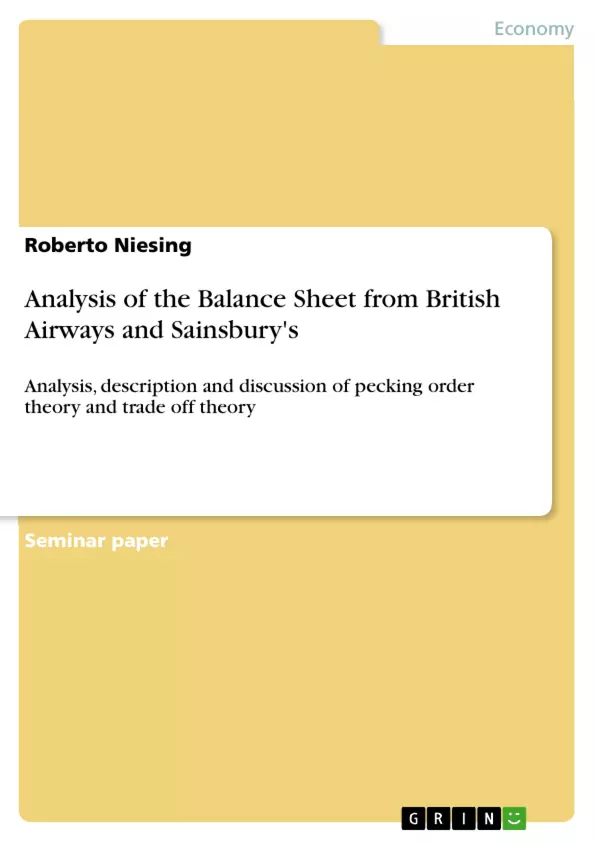The first part of this assignment was an analysis of the special indices of the Balance Sheet from British Airways and Sainsbury’s. The second part describes, analyses and discusses the pecking order theory and the trade off theory.
Inhaltsverzeichnis (Table of Contents)
- Part A:
- British Airways
- Sainsbury
- Part B:
- Part C
- Part D
- Appendix
- References
Zielsetzung und Themenschwerpunkte (Objectives and Key Themes)
This assignment aims to analyze the financial management of two prominent British companies, British Airways and Sainsbury, by examining their balance sheets and financial ratios. The analysis focuses on how these companies have managed their assets, liabilities, and equity over a five-year period, particularly in the context of the post-9/11 economic environment and the transition to IFRS accounting standards.
- Asset and liability management strategies
- The impact of IFRS accounting standards
- Financial leverage and gearing ratios
- Capital structure and financing decisions
- The golden rule of finance
Zusammenfassung der Kapitel (Chapter Summaries)
- British Airways: This chapter analyzes the changes in British Airways' balance sheet from 2003 to 2007. The analysis focuses on the company's asset reduction, particularly in terms of aircraft and property. The chapter also discusses the company's debt reduction strategies, its shift from UK GAAP to IFRS, and the impact on its gearing ratio. It further explores how British Airways manages its assets and liabilities in line with the golden rule of finance.
- Sainsbury: This chapter analyzes Sainsbury's balance sheet over the same period, highlighting the reduction in assets, specifically the decrease in current assets. It also examines the changes in Sainsbury's financing structure, including the increase in equity financing and the adoption of secured debt. The chapter further discusses the importance of short-term funding for Sainsbury and how the company manages its assets and liabilities to minimize business risk.
- Sainsbury: Part B: This chapter analyzes Sainsbury's financial performance indicators, specifically its interest cover ratio, debt-to-equity ratio, and inventory turnover ratio. It also examines the importance of these ratios for both internal and external stakeholders.
- British Airways: Part B: This chapter analyzes British Airways' financial performance indicators, specifically its interest cover ratio, debt-to-equity ratio. The chapter also examines the importance of these ratios for both internal and external stakeholders.
Schlüsselwörter (Keywords)
The key focus of this assignment is on financial management, balance sheet analysis, asset and liability management, gearing ratio, debt-to-equity ratio, interest cover ratio, IFRS accounting standards, and the golden rule of finance. The case studies of British Airways and Sainsbury offer a practical application of these concepts in the context of the airline and retail industries.
- Citar trabajo
- Roberto Niesing (Autor), 2008, Analysis of the Balance Sheet from British Airways and Sainsbury's, Múnich, GRIN Verlag, https://www.grin.com/document/92857



